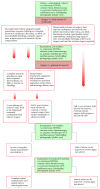Key Factors to Improve the Outcome of Retinal Reattachment Surgery in Proliferative Vitreoretinopathy and Proliferative Diabetic Retinopathy
- PMID: 28770107
- PMCID: PMC5523461
- DOI: 10.1155/2017/2323897
Key Factors to Improve the Outcome of Retinal Reattachment Surgery in Proliferative Vitreoretinopathy and Proliferative Diabetic Retinopathy
Abstract
Introduction: For management of complicated retinal detachments, a pars plana vitrectomy with temporary silicone oil (SO) fill is the method of choice. According to literature, the retinal redetachment rate varies between <10% and >70% with around 36% in our own group (retrospective data analysis, n = 119 eyes).
Methods: The main goal was to reduce the retinal redetachment rate. Standard operating procedures (SOPs) and evaluation protocols (EVALPs) were developed to prospectively analyse risk factors. Lab analysis of SO was performed, and the role of surgical experience was evaluated and investigated with Eyesi®.
Results: We achieved a significant reduction of the retinal redetachment rate (to 6.80%, n = 101, p = 0.002). After surgery with SO injection, neither further membrane peeling (in 16.5%) nor retinal laser coagulation (in 100%) during revision surgery had a significant effect on the reattachment rate (p = 0.167, p = 0.23), while extensive additional laser coagulation reduced visual acuity (p = 0.01). A 3-port approach had to be set up to complete SO removal. A difference in success rate depending on surgical experience was confirmed, and the performance in Eyesi correlated with that in the patients' eye.
Conclusions: A SOP- and EVALP-based management and new strategies to secure the surgical performance seem to be essential for successful surgery.
Figures



Similar articles
-
Timing of retinal redetachment after removal of intraocular silicone oil tamponade.Am J Ophthalmol. 1999 Nov;128(5):628-31. doi: 10.1016/s0002-9394(99)00201-9. Am J Ophthalmol. 1999. PMID: 10577533
-
Reduced rate of retinal detachment following silicone oil removal.Retina. 2000;20(6):597-603. doi: 10.1097/00006982-200011000-00002. Retina. 2000. PMID: 11131411
-
[Long-term outcome after silicone oil removal].Ophthalmologe. 1995 Oct;92(5):672-6. Ophthalmologe. 1995. PMID: 8750994 German.
-
Pars plana vitrectomy versus scleral buckling for repairing simple rhegmatogenous retinal detachments.Cochrane Database Syst Rev. 2019 Mar 8;3(3):CD009562. doi: 10.1002/14651858.CD009562.pub2. Cochrane Database Syst Rev. 2019. PMID: 30848830 Free PMC article.
-
Tamponade in surgery for retinal detachment associated with proliferative vitreoretinopathy.Cochrane Database Syst Rev. 2020 May 13;5(5):CD006126. doi: 10.1002/14651858.CD006126.pub4. Cochrane Database Syst Rev. 2020. PMID: 32408387 Free PMC article.
Cited by
-
Clinical effect of peripheral capsule preservation in eyes with silicone oil tamponade.World J Clin Cases. 2021 Sep 16;9(26):7729-7737. doi: 10.12998/wjcc.v9.i26.7729. World J Clin Cases. 2021. PMID: 34621823 Free PMC article.
-
Study on the effectiveness and safety of Foldable Capsular Vitreous Body implantation.BMC Ophthalmol. 2019 Dec 18;19(1):260. doi: 10.1186/s12886-019-1268-x. BMC Ophthalmol. 2019. PMID: 31852464 Free PMC article.
References
-
- Hoerauf H., Roider J., Bopp S., Lucke K., Laqua H. Endotamponade with silicon oil in severe proliferative retinopathy with attached retina. Ophthalmology. 1995;92:657–662. - PubMed
-
- Abrams G. W., Azen S. P., McCuen B. W., II, Flynn H. W., Jr., Lai M. Y., Ryan S. J. Vitrectomy with silicone oil or long acting gas in eyes with severe PVR: results of additional and long-term follow-up. Silicone study report 11. Archives of Ophthalmology. 1997;115:335–344. doi: 10.1001/archopht.1997.01100150337005. - DOI - PubMed
LinkOut - more resources
Full Text Sources
Other Literature Sources
Miscellaneous

